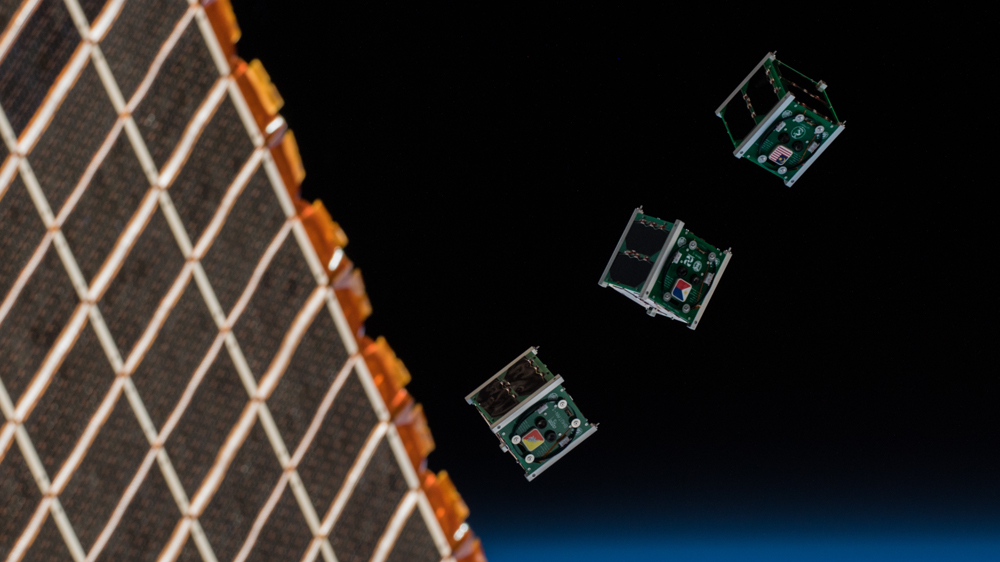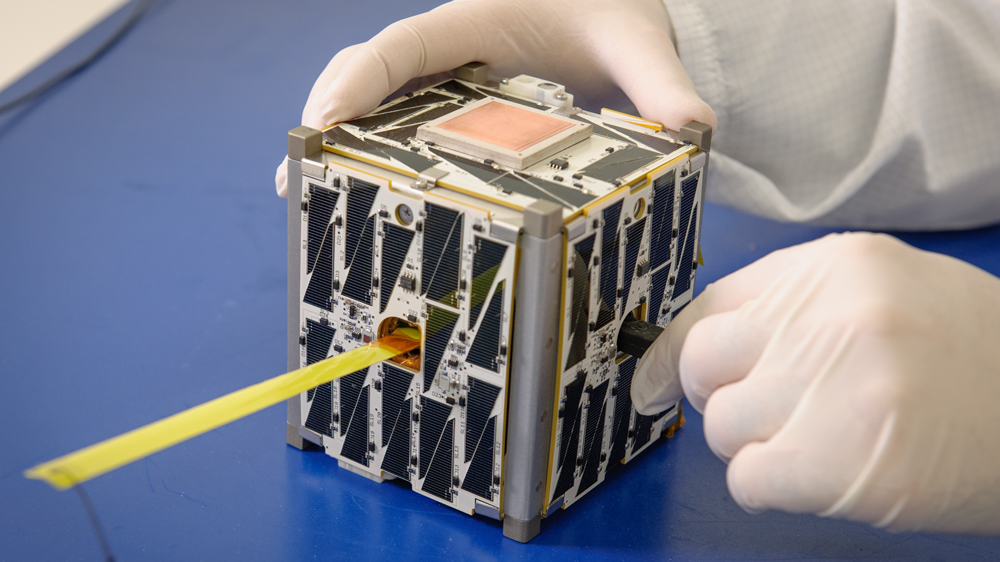Cubesats: the little satellites that could help us reach Mars
Small satellites, giant leaps

Main image: Cubesats being released from the International Space Station. Credit: ESA/NASA-A. Gerst
Smartphones haven’t just changed the world, they’re changing space too. Over the past couple of decades, we’ve watched as manufacturers have furiously competed to engineer faster, leaner, and higher-quality components for use in the latest phones. But it turns out that the mobile parts boom is useful for the satellite business too.
Since they were first proposed in 1999, a community has grown up around the idea of building satellites that are significantly smaller and cheaper to launch, built in part from newly commoditized components. The idea is that these 'cubesats' can be sent up to space, potentially dozens at a time, piggybacking on other space missions as a secondary payload.
On June 12 2013 an Atlas rocket blasted off from Vandenberg Air Force Base in California carrying several satellites. The biggest was a seven-tonne military communications satellite – and the smallest were a pair of cubesats that weighed less than 2kg each, called AeroCube 5a and 5b.
A 'camera-phone in space'
Launched by the Aerospace Corporation, the AeroCubes' primary mission was to test a new communications technology, but following their launch Dee W Pack from The Aerospace Corporation found another use. He used their on-board cameras to prove that cubesats can be just as capable of taking photos of the Earth as full-sized satellites.
“The thought crossed my mind that the tiny cameras we had on some of our AeroCubes – our Aerospace cubesats – could be used at night,” Pack says. Having been inspired by the incredible night time photography of a colleague at the National Oceanic and Atmospheric Administration, and thinking of the impressive photography that astronaut Donald Pettit had managed from the International Space Station, he wanted to see how cubesats measured up.

On a technical level, the on-board cameras are probably not even as high-spec as the camera in your phone: “They're megapixel cameras, but they're not up to today’s standards because they were built a few years ago, and they're equipped with very inexpensive lenses”, Pack explains. “The trick is in the pointing of the satellite so you can expose the tiny camera for approximately 0.2 or 0.3 seconds and get a somewhat longer exposure so your image doesn't streak”.
Get daily insight, inspiration and deals in your inbox
Sign up for breaking news, reviews, opinion, top tech deals, and more.
But this limited capability doesn’t mean the cubesats cameras can’t be useful, even compared to photography from the vastly more expensive VIIRS, a full-sized infrared camera on board on a full-sized satellite. In fact, for certain applications the camera on the AeroCubes is even better: not only is it full color, but the satellites are in a lower orbit they can capture images of the ground at a resolution of around 100m for every pixel, rather than the 740m of VIIRS. This means you can see individual streets – which is exactly what you need if you want to monitor, say, urban growth or light pollution.
Up-to-date imagery
One other intriguing application that’s currently being worked on is 'GPS occultation'. The idea is that a cubesat could be used to receive GPS signals that have travelled through the Earth’s atmosphere, and measuring how the signals have been refracted it could enable scientists to make even more accurate weather forecasts.
Perhaps the clearest benefit of using cubesats, though, is something that normal satellites can't cheaply replicate: 'refresh rate'. Geostationary satellites, which maintain a fixed position relative to the Earth, can only orbit above the equator, which isn’t useful for aerial photography or other types of observations. Satellites that photography the Earth have to be in less regular orbits, which means they won’t always be above the same places – hence why Google Maps only refreshes its imagery every few years. But this is only a problem if you only have one massive, expensive camera.

As cubesats are cheaper and easier to make, they'e easier to launch en masse – so you could conceivably have many satellites with many cameras, taking more photos, and buzzing over our heads more regularly.
“If you can put a large number of sensors in orbit you begin to get [...] near real-time updates of what is going on at any given point on the planet, and this has very interesting Earth Science applications in terms of being able to monitor change [such as] the aftermath of severe weather events,” says Chris Baker, who runs NASA’s Small Spacecraft Technology program. He also points to an intriguing future where CubeSats could become, effectively, an early warning system.
“It requires some degree of autonomy, but say if the spacecraft can detect the initiation of that forest fire, it can warn assets on the ground, or potentially warn a larger [satellite] in orbit [saying]: 'Hey there's something interesting over here, swivel your camera in this direction and take a higher-resolution picture so we can tell what’s going on’.”
Less cost, less risk
What’s most exciting though, is the second-order consequence of cheaper launches: faster innovation.
“The space industry has until recently been extremely risk-averse,” says Rafael Jorda-Siquier, CEO of Open Cosmos, an Oxford-based space startup, which is aiming to provide space launches for as little as £500,000 (about $650,000 or AU$900,000). He says that traditionally, space technology has been stuck in what he calls a “vicious cycle”.
“The more expensive the technology is, the more you want to test on the ground so you make sure that it works,“ he says. “You end up with a massive satellite, [that’s] very expensive, all over-engineered and in many cases using old technology. In space this usually means they fly obsolete technologies and they fly microchips from the 1980s.“
Cubesats, however, can short-circuit this cycle and enable space technology to be upgraded faster, as they're cheaper to build and there's less money at risk if they don’t work or go wrong.

“The fact that some of these spacecrafts deorbit rather quickly is seen by some in the industry as an asset, because they already have the next generation waiting for launch,” notes NASA’s Chris Baker. And the best part? Technology mastered on cubesats could eventually help take us to Mars.
“The scale of what is possible on a small satellite is actually not too far from what the scale that is required on a manned vehicle,” says Baker, who is thinking about NASA’s new Orion space capsule for humans, which is currently under development.
“While that is a large spacecraft, the majority of the space is devoted to the humans. A communications system that sits on a cubesat, for example, would most certainly sit on the Orion crew vehicles. So there’s the potential for the technologies being tested on small spacecraft to provide early and more frequent opportunities to test mission-enhancing capabilities for human exploration.”
So perhaps when humans finally do get around to heading to Mars, they could be on their way thanks to a little push from some rather diminutive satellites.
James O’Malley tweets as @Psythor.
TechRadar's Next Up series is brought to you in association with Honor
